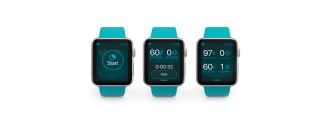Updated, 12/02/20, 9:00 AM EDT: This article title and body was updated to reflect how a patient receives the NightWare prescription.
Today, health and technology are intrinsically linked — we use wellness apps to track our mental health, wearables to monitor our heart rates, and video chat platforms to talk to our doctors.
Most of these digital therapeutics don’t require a prescription from a doctor — but there are some that do.
Prescription digital therapeutics are backed by clinical data and must be authorized by the FDA. Whether or not a software-based product requires a prescription comes down to a combination of factors, including the product’s claims, whether it’s designed to work concurrently with other therapies, and its intended use setting.
Prescription digital therapeutics are still relatively new, but they’ve already shown promise at helping patients with everything from diabetes to drug addiction — and the latest to receive the green light from the FDA is a watch for preventing nightmares.
A Watch Takes on Nightmare Disorder
The new prescription digital therapeutic is called NightWare, and it works with the Apple Watch to treat nightmare disorder, a condition often linked to PTSD.
People with nightmare disorder experience regular nightmares that can affect both their sleep and their ability to function when awake. They might even be afraid to go to sleep at all.
If granted a prescription for NightWare to treat their nightmare disorder, a patient receives an Apple Watch with the app pre-installed and starts wearing it while sleeping. (The Apple Watch is designed to only support the NightWare program — nothing else can be installed on it.)
At first, the watch’s AI software focuses on learning the wearer’s sleep patterns, a process that takes about three to 10 days. After that learning period, it can sense from the wearer’s heart rate and movement when a nightmare may be about to start.
The smart watch will then intervene prior to a nightmare, vibrating just enough to prevent it from happening but not so much that the wearer wakes up. If the vibration does wake up the wearer, the watch adjusts, vibrating less the next time a nightmare is on the horizon.
During a 30-day trial involving 70 patients with PTSD-related nightmare disorder, the sleep quality of those who used the NightWare watch increased more significantly than those who wore the Apple Watch but didn’t receive any vibrations. (The quality of sleep was determined via a commonly used self-rated questionnaire.)
A larger trial involving 240 patients from several Department of Veterans Affairs hospitals is ongoing and plans to wrap up next year.
The Future of Prescription Digital Therapeutics
The potential for prescription digital therapeutics like NightWare is high. They aren’t likely to produce unwanted side effects, which makes them low risk, and based on the products already out, they can help with an array of health problems.
They also allow doctors to collect real-world data from patients — for example, their sleep patterns — that can help doctors more precisely treat the disease.
Digital therapeutics aren’t likely to affect the efficacy of other interventions, such as medications, either, so doctors could — and should — prescribe them as part of a whole treatment package, according to NightWare CCO Matthew Tucker.
“Instead of thinking of these categories as separate, we should be thinking of how we can combine them for a better effect in which one plus one equals three,” he told Freethink.
Tucker noted that one of the biggest barriers prescription digital therapeutics face right now is their general “newness” — until they’re more common, healthcare providers and insurance companies may be hesitant to prescribe or cover the therapies.
However, that’s a problem that could be solved with time.
“As more companies bring to market digital therapeutics that go through the FDA regulatory process and generate high-quality data, we will see new ways to treat diseases that can benefit millions of patients,” Tucker said.
“With that,” he continued, “insurance companies, hospital systems, and other health care providers will increase support for these products, which we would expect to facilitate greater availability for patients.”
The need to go through the time-consuming and costly process of working with the FDA can be another barrier — but it’s one that could prove worthwhile for developers, according to Tucker.
“You get credibility,” he said. “The FDA is standing behind your product and it helps you have conversations with customers, patients, and providers, because you can more easily cut through the noise.”
We’d love to hear from you! If you have a comment about this article or if you have a tip for a future Freethink story, please email us at tips@freethink.com.






